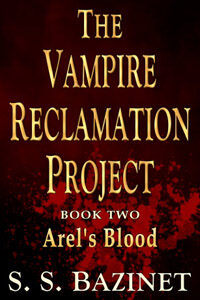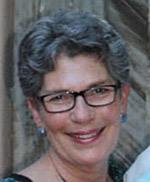After years of writer’s block, S.S. Bazinet gave in to her creative muse and has been passionately writing ever since. She is the author of the visionary fantasy series The Vampire Reclamation Project. She has also published two other fantasy books, a children’s book, and a self-help book. Stop by her website at ssbazinet.com to see what she’s up to and read interviews she’s posted with authors like Anne Hillerman, Joseph Badal, Slim Randles, Sarah Baker, and Steve Brewer. Better yet, stop by the snack table at the next SouthWest Writers meeting. She’ll be the bright light at the back of the room encouraging everyone to pursue their dreams.
 When readers turn the last page of one of your books, what do you hope they’ll say about it? I hope that they feel entertained, satisfied and uplifted. One of my readers expressed my desire best in her review when she wrote, “If you’ve ever had nightmares about unspeakable horrors, and you know inexplicably that man’s inhumanity to man is part of your personal history, this book will ultimately give you courage to carry on.”
When readers turn the last page of one of your books, what do you hope they’ll say about it? I hope that they feel entertained, satisfied and uplifted. One of my readers expressed my desire best in her review when she wrote, “If you’ve ever had nightmares about unspeakable horrors, and you know inexplicably that man’s inhumanity to man is part of your personal history, this book will ultimately give you courage to carry on.”
Give us your elevator pitch for your book series, The Vampire Reclamation Project. This series is a grand journey of the spirit with angels, vampires and everyday people coming together to reclaim lost lives. Resolving issues surrounding love, hate, trust and betrayal, they struggle to find ways to reach for the stars while grounding themselves in brotherhood.
How was writing this series different from your other projects? From the moment I started writing it, I was possessed with a need to tell the story. I wrote for ten and twelve hours a day, sometimes more. I barely slept. Most nights I got maybe four hours of sleep, but I wasn’t tired. I’d get up around 3:00 or 4:00 a.m., write for a while, then take three mile walks. The creative fount I tapped into gave me everything I needed to complete not only the first book, but five more in the series in the year that followed. I’ve since completed a seventh book and have the eighth one waiting to take form.
Where did the inspiration for the story come from? I never planned to write a book about vampires or angels. Instead, I got fed up with having writer’s block. One day I decided to just have fun and not care about writing for anyone but me. That decision seemed to be the permission slip I needed to open the doors to my creativity. When I sat down with pad and pencil, the story flowed out on its own. Yet it contained all the things I felt passionate about. Soon I needed a keyboard to keep up with the torrent of words and feelings that poured forth from my heart and soul. The first book was completed in a little over a month. However, I did about nine edits on the novel before I felt I’d done it justice.
What was the most rewarding aspect of writing Michael’s Blood, the first book in the series? Writing the series gave me an opportunity to purge many deep down, sometimes hidden, fears–the ones I didn’t have the courage to face head on. At times, I doubted my ability to plunge into the depths of pain the story required me to understand and then to give it a voice. When I completed the first six books in the series, I felt a little like my character, Arel. We had both reclaimed large portions of our lives.
What are the challenges in writing a series? The characters keep evolving with each successive book. As they gradually reveal more of their complex natures, it impacts the overall story. That poses a problem when it comes to editing. I usually have to scrap large portions of the original manuscripts.
Which of your books did you enjoy writing the most? I didn’t think I could write a thriller, but my novel In the Care of Wolves surprised me. It started off rather innocently, but quickly demanded that I find a way to express the non-stop action and emotional upheaval that drives the story. When I finished the book, I felt a wonderful sense of pride and achievement.
What first inspired you to become a writer? The inspiration has always come from within, from the “greater” me that doesn’t seem to know anything but possibility and the joy of creation. However, to truly access that part of myself, I have to let go of all my expectations about writing and the story I’m telling. I have to allow whatever wants to come forth, whether it is dark or light, to have a voice. When I do, when I put aside my judgments and criticisms, I experience a true lightness of being.
What do you struggle with most in your writing? One of the fears I still entertain is that I’ve purged so much of my angst–and I’m generally so happy with my life–that I won’t have the ability to write passionate stories anymore. However, I recently started a new novel that soothed my fear. All the depths of feeling within are not only available, but my ability to express emotion is better than ever. What a thrill that is.
Why do you write in the fantasy genre? I love fantasy because I love to create worlds that go beyond the boundaries of the reality we live in. These worlds allow my characters to do whatever they need to do to free themselves from situations and belief systems that have kept them shackled. More than anything, I’d like to be thought of as a writer who helps people to strip away the barriers that keep them from connecting with who they are on a heart and soul level.
Do you have unfinished projects keeping you busy? I’m in the final stages of editing book three of the vampire series. I have another novel, The Madonna Diaries, that’s nearly finished. It’s written with a first person POV. It wasn’t something I planned, but once I realized I’d slipped into first person, I enjoyed it and decided it was right for the story. I recommend that every writer give first person POV a try. It can provide an opportunity to delve deeper into the main character’s view of life.
Which has been more challenging for you—writing or promoting? Promoting has been more of a challenge, but maybe that’s a good thing. I’m overcoming more fears as I learn how to get my creations out in the world. SouthWest Writers has been a blessing in that regard. The organization provides a great environment for writers to grow in knowledge and self-confidence. With these attributes under one’s belt, promoting becomes easier.
Is there anything else you’d like readers to know? Writing can be a box with rigid structures that are demanding and restrictive to one’s creative nature. On the other hand, writing can be as fluid as the ink that flows onto the paper. It can become a vehicle that opens up doors to new worlds of possibility and to dreams that have never been expressed. My hope is that every writer who feels the need for more freedom chooses the latter.
 KL Wagoner (writing as Cate Macabe) is the author of This New Mountain: a memoir of AJ Jackson, private investigator, repossessor, and grandmother. KL has a new speculative fiction blog at klwagoner.com and writes about memoir at ThisNewMountain.com.
KL Wagoner (writing as Cate Macabe) is the author of This New Mountain: a memoir of AJ Jackson, private investigator, repossessor, and grandmother. KL has a new speculative fiction blog at klwagoner.com and writes about memoir at ThisNewMountain.com.

 Joanne Matzenbacher does email marketing for independent bookstore
Joanne Matzenbacher does email marketing for independent bookstore 


